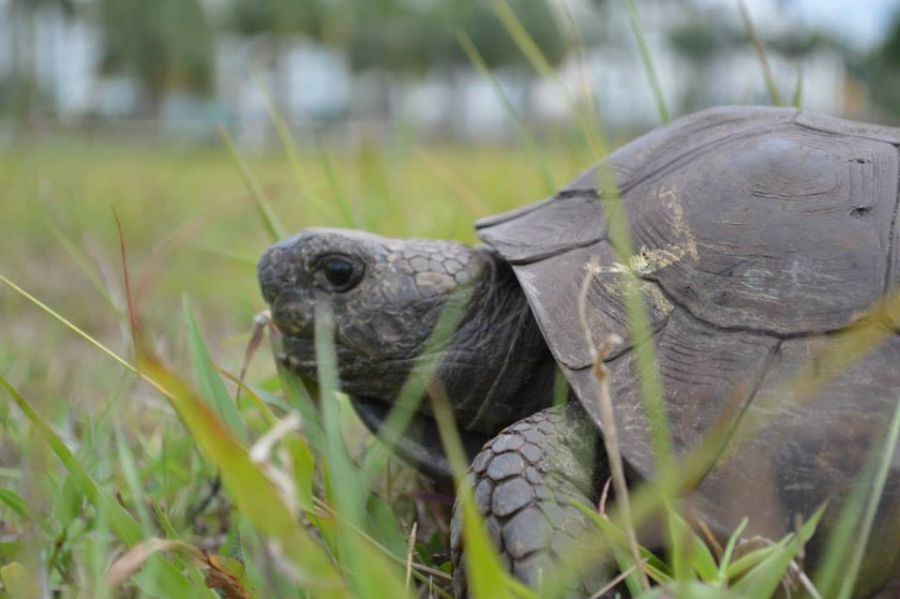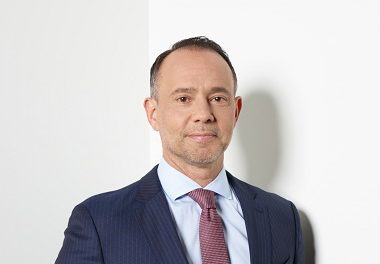FAU’s threatened gopher tortoise population is disappearing
And if they die off, so do several other species.
Gopher Tortoises provide shelter and resources for other species at FAU’s nature preserve —but they are in danger. Photo courtesy of FAU.
February 19, 2019
Editor’s note: This story has been corrected from our print issue to reflect that Susan Norman’s name is Sandra Norman.
For the past five years, researchers haven’t been able to find gopher tortoise eggs on FAU’s ecological preserve. In 2014, there was nothing. In additional random sampling searches throughout the years, the result was the same. A nest was found in 2016, but it was filled with nothing but nine rotten eggs.
There are over 350 other species on the preserve — including burrowing owls, mice, snakes, rabbits, frogs, and the occasional coyote. But none are as important as the gopher tortoise.
There’s about 100 of them at FAU. Approximately nine to 11 inches long and weighing up to an average of 15 pounds, the stout reptile’s powerful legs act as shovels, scooping tunnels nearly 10 feet deep to escape the heat. Other animals use these burrows for shelter and survival, making the gopher tortoise a “keystone species” — but they’re also a threatened species, according to the Florida Fish and Wildlife Conservation Commission.
Most of the tortoises at FAU are old, said Evelyn Frazier, a professor of ecology and entomology at FAU. She and her students have been studying the preserve since 2009, and during the last published count of tortoises in 2012, only seven young were found — not nearly enough to replace the elders. The results of newer studies haven’t fared much better, Frazier added.
It doesn’t help that some students have run over pregnant tortoises, either.
“It is possible that this population won’t sustain itself,” Frazier said.
What will happen if the tortoises disappear?
FAU has 19 species of vertebrates and hundreds of invertebrates that use the gopher tortoise burrows, according to Frazier — one being FAU’s mascot, the burrowing owl.
Contrary to its name, the burrowing owl does not actually dig its own burrows. Instead, it takes advantage of the gopher tortoise’s home. So if the tortoises disappear, “most likely the burrowing owls will too because there will be nobody to make burrows for them,” Frazier said.
The other 18 species will be out of a place to live as well, Frazier added — and some of these groups are threatened or endangered.
“The loss of so many species would drastically change the ecosystem. It’s not just about a cute, head-bobbing tortoise or his friends. It’s the impact on the ecosystem that is ultimately at stake here,” Park Naturalist and Manager of Deerfield Island Park Katherine Hendrickson said.
But the fate of the gopher tortoises isn’t only a concern for the animals. Students will no longer have an accessible place to study wildlife in its natural habitat.
“Other universities, they will have the research spaces, but they have to get in the cars and vans and drive off to them. Here, you walk across the street … It’s really rather unique among universities around here to have a living, working space of laboratory right on campus,” Sandra Norman, an associate professor who specializes in environmental studies at FAU, said.
Why are the tortoises disappearing?
Nobody knows for sure why the tortoise population is declining, but researchers have a few guesses.
Lack of land
One theory is that the population is overcrowded, which can put stress on the females and cause them to “retain,” or simply not lay the eggs, Frazier said. The preserve used to be 120 acres, but the construction of the FAU football stadium in 2011 bit into the land, shrinking it to 90 acres.
It may be even smaller than that in the future. FAU has a Conservation Committee that meets bi-monthly to manage the campus’ habitat land, and they have considered taking out another portion of the preserve to build more parking lots, according to Norman, who is a committee member.
Lack of controlled burns
In other preserves, the scrubland is set on fire to thin out large expanses of the canopy and stabilize the environment for the tortoises. However, because of how close the FAU football stadium, Boca Raton airport, and Glades road are to the grounds, it is nearly impossible to go through with it.
As an alternative, the preserve is mechanically cleared to thin out the foliage.
These methods remove all food sources, requiring tortoises to put their energy toward scavenging a meal when they should be using that energy to find a mate, protect themselves from perceived dangers, or obtain other necessities, Hendrickson said.
Extreme heat
Another possibility is that, with global climate change, Florida’s already blistering heat is only getting hotter, killing the tortoises before they hatch. One of the nine rotten eggs found in 2016 “was cooked through like a chicken egg,” Frazier said.
By 2055, the temperature in Florida will likely be over 95 degrees Fahrenheit for more than 50 days of the year, according to the National Oceanic and Atmospheric Administration.
High temperatures normally aren’t an issue for grown tortoises, but they can dictate which species are living in an ecosystem, according to Hendrickson. And if they aren’t friendly to the tortoises, it can be a problem.
Predation
The heat doesn’t matter if the eggs are being eaten before the sun can get to them.
“The higher temperatures do allow new species to move into habitats that they normally wouldn’t have been comfortable in and thus they become another predator for the tortoise to deal with. Whether these new species are direct predators and eat the tortoise eggs or just eat very similar food, each of these issues can greatly impact the gopher tortoise,” she said.
Frazier and her team often find eggshell fragments around the preserve, but they don’t know which species is doing the predation. They think it could be the visiting coyotes, however.
They have placed cameras by 12 burrows in the preserve, and they see coyotes sniffing around them all of the time. However, they could just be looking for the rabbits that share the burrows with the tortoises. As of right now, there’s no way to tell, Frazier said.
What are people doing to help?
Both seasoned researchers and college students are doing their share to prop up the gopher tortoise population.
Professionals
To solidify better regulations and rules for South Florida gopher tortoises, Frazier is teaming up with other biologists around the state to prove that these tortoises are genetically distinct from others, and therefore require special protection from the Florida Fish and Wildlife Conservation Committee.
The strongest evidence of this is that gopher tortoises in South Florida do not hibernate, while others in the state and around the country do, Frazier said. Florida’s climate allows the tortoises to be active year-round.
Most studies of gopher tortoises are done in northern Florida, while the southern tortoises go neglected, wildlife biologist Steve Whitfield from Zoo Miami, who also specializes in conservation and research, said. He first met Frazier at Florida’s Gopher Tortoise Council, and they joined forces to study the tortoises.
“Because Southern Florida, particularly the coastal counties, are so well-developed, people assumed that any tortoises that lived down here had been wiped out decades ago. And what we find through South Florida is when we have these little urban parks, they often tend to have tortoises still in them. So they’re not completely gone — at least, not yet,” he said.
Along with the lack of hibernation, the studies look to answer several other questions: which plants are the tortoises eating? Is their breeding season the same as others, or is it affected by South Florida’s heat? How many tortoises are there? How much habitat do they use?
“The future of tortoises as Florida continues to develop is to live in more and more habitat patches surrounded by suburban and urban areas,” Whitfield said. “Our hope is that studying these tortoises in Miami will help us kind of understand what we need to do to protect tortoises around the state as the state becomes more urban in the future.”
Students
Not everything is being left to the professionals, however. FAU students are pitching in, too. With grants from FAU’s Office of Undergraduate Research — $600 for individuals and $1,200 for groups — some will track six female gopher tortoises with radio transmitters and sample “every single inch” of the area that they’re in for a whole year, Frazier said. This will help them understand where the eggs are being laid and find out what is happening to them.
And another student group dedicated to the preserve is SEEDS, or the Strategies for Ecology Education, Diversity & Sustainability.
SEEDS is an on-campus ecology club focused on sustainability and conservation efforts, and they have been responsible for clearing and maintaining Tortuga trail since 2011, which makes it easier for students to access the preserve. Outside the classroom, Frazier is one of their advisors.
One of SEEDS’ missions is to educate FAU students about the preserve because most students are completely unaware of its existence, SEEDS Vice President Rousse Bidon said.
“Being in SEEDS and learning about the tortoises, I got really interested in the environment and ecology,” Bidon said. “[Tortoises] are endangered and on our campus, so it kind of shows how human involvement contributes to the downfall of animals.”
But ultimately, members like SEEDS Treasurer Estanfania Abbate believe “we can do something about it.”
SEEDS hosts annual events to encourage student engagement in favor of the preserve. Last year they held a Halloween-themed pumpkin carving and composting event and tested out a “Fun Run” along the preserve’s trails. They also encourage students to remember that the preserve is there for the animals, not the people — because although many don’t know about the grounds, some are a little too familiar with them.
Students have made campfires out of the preserve’s wooden benches and signs. Others harass the animals, often with dogs who will make a beeline for the gopher tortoise burrows and dig around them, Norman said. The preserve is also no stranger to trash, especially with the FAU football stadium in close proximity.
“There is a lot of evidence of people littering on the preserve … I went out there one time, there was this big dumpster [overflowing] with trash, and there was probably 50 vultures circling. They hire people to clean up after the tailgate, and they don’t seem to be doing a very good job of it,” SEEDS President Avery Knoll said. Knoll also said she has found drug paraphernalia on the grounds.
Members of SEEDS ultimately hope that FAU will show more care toward the preserve, inform the students of its existence, and make it an important part of the campus.“It’s part of our university. It’s what makes us special,” Abbate said.
Preserving history
The roots of FAU’s ecological preserve go back almost 80 years.
In the 1940s, what is now FAU’s ecological preserve was a patch of ignored land between the runways and roads making up the Boca Raton Army Air Field, which aided the Allies during the Second World War. In the 1960s, FAU’s first professors began to take students into the unnamed space to observe and study wildlife. And in 2019 it’s the FAU Ecological Site, otherwise known as “the preserve.”
All of this is according to associate professor of environmental history and FAU Conservation Committee member Sandra Norman, who has been at the university since 1988. Her department has taken to calling her “the historian,” even though it’s not an official title, and she knows almost everything there is to know about the preserve — especially because she was there for its informal beginning.
Although students and teachers have been taking advantage of the preserve since FAU’s beginning, it wasn’t established as a “preserve” until the late 1980s, which had a lot to do with an FAU faculty member named Dan Austin. He was the “loud voice” who kickstarted the environmental committees and recruited people in the interest of the preserve, Norman said. The university only had about 9,000 students at that time, but he could see that it was growing and wanted to protect the land.
“Dan was the one who said, ‘You know, we have a really nice spot here that we can do something with,’” she said. “If they were smart they would rename the preserve for Dan Austin.”
FAU has taken “bites” out of the preserve since then, the biggest being its 120 acre to 90 acre downsize for the football stadium construction in 2011, but Norman says that the current administration understands the importance of the preserve.
And due to its protected animal populations, the Florida Fish and Wildlife Conservation keeps an eye on construction that would threaten the species, she added — although some have certainly tried to develop the land.
“You get the planners who come in and say, ‘We can tear [the preserve] down and put dorms there’ … And we said, ‘Well, there’s this thing that we are an educational institution. And being able to actually engage in education is actually good.’ And tearing it down and putting in more dorms or athletic space or another stadium or this and that may look nice, but none of those things contribute to education,” Norman said, referring to “education” as the studies that students do in the preserve.
Israel Fontoura is a contributing writer for the University Press. For more information regarding this or other stories, email at [email protected].

















Peter Maestrales • Feb 20, 2019 at 10:14 am
Oh boy, so is it global warming or climate change killing off the turtles? Do they make you say that?
Am I suffering from climate change denial? Or just smarter than you?
Maybe it’s the exhaust changing the climate and killing all the turtles lol.